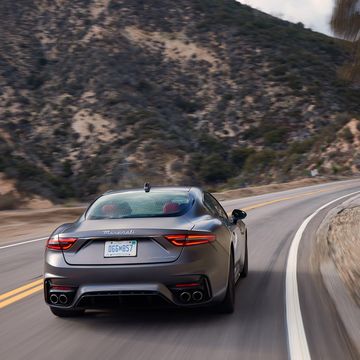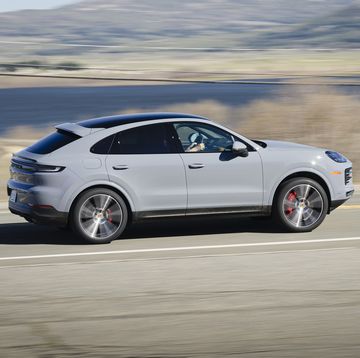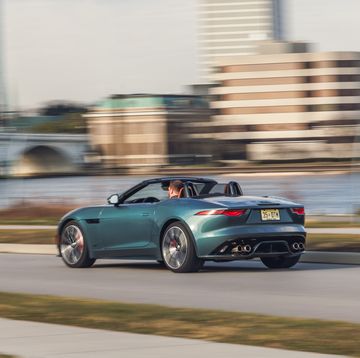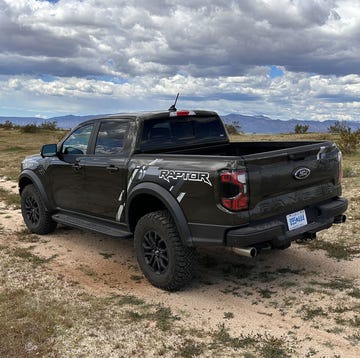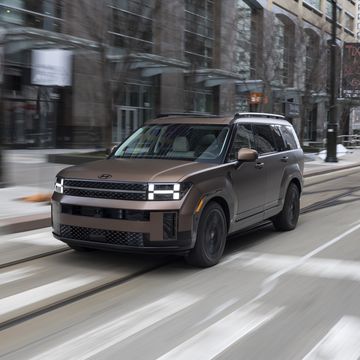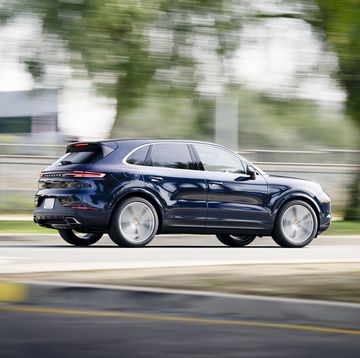From the October 1996 Issue of Car and Driver.
Last time we wrapped our hands around a Prowler, "Tonya X" wrecked the thing (C/D, 1996 April Fools' issue). Well, not totally, but she tore off both front wheels, planted a blue spruce in the engine bay, and there was the not-inconsequential matter of a medium-sized fire. Still, she loves this neo-hot rod, even if ZZ Top has not yet fully endorsed it: "You can hear sirens a mile away," she squealed. "Headrests make perfect beach-towel drying racks."
Well, okay. But now we're back for a serious exam, and we're proud to have obtained the world's first Prowler test measurements. We'll get to those numbers in a moment. First, here's what's happened since Tonya's excellent adventure.
For starters, Chrysler has stuck to its promise of a lightweight vehicle. When we weighed the prototype you see here—the very first Prowler that the company considers even remotely close to production trim—it clocked in at a flyweight 2832 pounds. About the same heft as a Ford Probe.
Nearly 900 of those pounds are to be found in aluminum—everything from the alloy hood, decklid, and doors (from supplier Mayflower Vehicle Systems) to the control arms and steering knuckles (from Alumax) to the frame and crossmembers (by Alcoa). To shave even more ounces, the huge lateral brace under the dashboard was fashioned from magnesium, and the engine’s original cast-iron exhaust manifolds were junked in favor of stainless-steel versions.
Also new since we last examined this roadster are its four Bosch projector-beam headlamps, now somewhat bug-eyed in a fairing that bulges toward the front wheels. The early flush headlamps created a motorcycle-like single pencil beam at night, whereas the new placement achieves modest separation.
Finally finished, too, is the soft top, from supplier Dura Convertible Systems. Unlike the original Viper's impractical build-it-yourself ragtop, the Prowler's is a taut, tight piece, complete with a glass backlight and electric defroster. To lower this manual lid, you first unfasten two windshield-header latches, then pull a lever that releases a pair of locating pins embedded in the trunklid. Next, you flop the backlight forward, then you punch a yellow button that allows the trunk to open. The whole top falls into a flat, neat heap back there. It sounds complex, but the entire process cost us about 35 seconds, and because the top is completely hidden in the trunk, no tonneau is required. Our single complaint: We wish the top had some sort of headliner to hide its ugly steel reinforcing braces. The trunk, by the way, opens front to rear and is about five inches deep—useful only for one, maybe two garment bags laid flat.
Climb into the Prowler's cockpit and you'll trip over a heap of familiar corporate pieces. The side-view-mirror controls are from the LH sedan. The interior door handles are out of the Viper, as are the gauge faces. The HVAC controls are from the Neon, and the plastic vent grilles are yanked from the minivan. And both the steering column and the turn-signal stalk are sourced from the Grand Cherokee. (The apparent rollover bars above each seat, you should know, aren’t; they're nothing more than somewhat uncomfortably hard headrests.)
This interdivisional parts pirating is no bad thing. Look around and you'd swear you were inside any modern, mid-priced automobile. Let's see . . . here are the cruise-control buttons on the steering-wheel spokes, the six-CD changer is behind the passenger seat, the PRNDL readout is displayed in light-emitting diodes, and . . . wait! Ain't this a hot rod? Well, theoretically. But inside, there are only three clues to the Prowler's alleged outlaw persona: the tack-on Autometer tach, the center-of-the-dash instrument cluster, and a cowl so high that you'll swear you're sitting inside a Dumpster. No kidding, after making myself comfortable in the leather seat—raised to its highest setting—I found that the door side panel was only two inches below my left ear.
Nonetheless, visibility is satisfactory, partly because you sit bolt upright and high, and partly because of the large, cleverly twisted side-view mirrors that afford a glimpse of what's behind this car's Roseanne-wide rump. (The Prowler's rear track is as broad as a Ferrari F50's.) Strangely, what you can’t see is even one millimeter of the Prowler's hood. "Every guy who drives this thing initially nails a curb," admits development engineer Will Knudsen, who then pointed to the car's jutting plastic proboscis. It rides exactly 4.5 inches above the tarmac. As "Tonya X" warned, "Beer cans get stuck under it. What a racket!"
Most folks now know that the Prowler isn't offered with a manual transmission. To mitigate this glaring omission in a hot rod, Chrysler has done two things. First, in the rear of the Prowler, the company installed a reworked version of the quasi-manual four-speed AutoStick transaxle found in the Eagle Vision TSi. Second, the transmission has been programmed to shift hard and abruptly under every circumstance. In the Prowler, the AutoStick becomes a particularly useful contrivance. For instance, if you select a gear, the transmission will hold that gear even as you run the engine smack into its 6350-rpm fuel-shutoff governor. Which we did repeatedly. Should you wish to make a slow getaway—perhaps in gravel or snow—you can bump the selector into second or even third, then creep away from a standstill. On downshifts, too, the AutoStick follows your every command: Fourth to first? No sweat, as long as it won't zing the engine past 6350 rpm.
Specifications
John Phillips first began writing about cars in 1974, at Car Weekly in Toronto. He later worked for Ford Racing, then served for seven years as the Executive Editor of Car and Driver. In the interim, he has written for Harper's, Sports Illustrated, The Toronto Globe and Mail, The Cleveland Plain Dealer, and Conde Nast Traveler. He enjoyed a one-on-one interview with Joe Biden and is the author of the true-crime saga God Wants You to Roll and the memoir Four Miles West of Nowhere. In 2007 he won the Ken Purdy Award for journalism. He lives with his wife, Julie, in the Bitterroot Valley.









